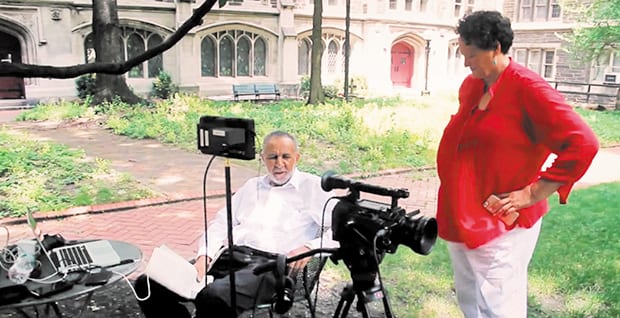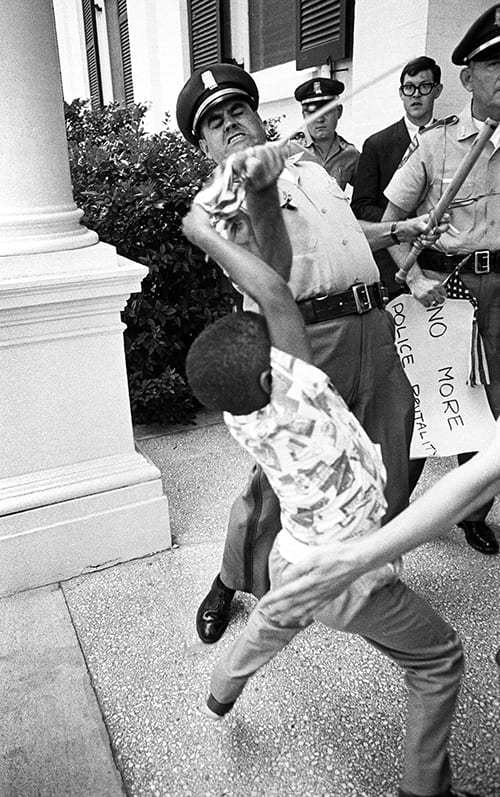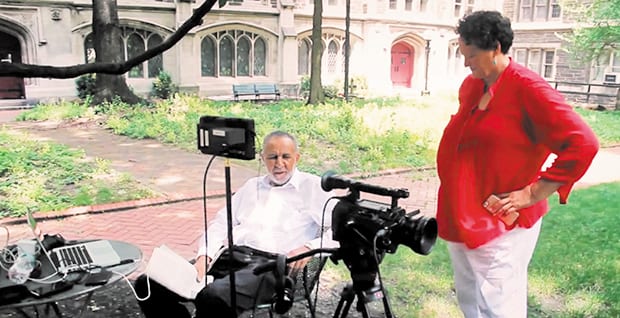A white lesbian and a black male minister, both with histories of discrimination in Dallas, traveled the country to explore the civil rights and LGBT equality movements

Gil Caldwell and Marilyn Bennett, on location at Union Theological Seminary. (A screenshot from their movie, From Selma to Stonewall: Are We There Yet?).
DAVID TAFFET | Senior Staff Writer
When I spoke to Marilyn Bennett and the Rev. Gil Caldwell, I didn’t quite interview them. Rather, I eavesdropped on their conversation.
Bennett and Caldwell, who each have history in Dallas, will be in town next week for several screenings of their new documentary, From Selma to Stonewall: Are We There Yet. Bennett, who was known as Marilyn Alexander when she lived in Dallas and served as development director for Resource Center and later worked at SMU, was fired from the university after she published her book, We Were Baptized Too.
“Because I was out and outspoken, there was a fear it would hurt the school,” she said.
The dean, she said, listened to conservatives and wanted to move her to a much less visible position, despite six years of good work, before finally moving her out.
In the mid-1940s, Caldwell lived across the street from Booker T. Washington High School in downtown Dallas and faced the discrimination of going to the segregated high school.

Mississippi Highway patrolman, left, Huey Krohn arrests Anthony Quin, 5, son of Mrs. Aylene Quin of McComb, Mississippi during a voting rights protest. (Photo by Matt Herron
“Negro Day at the State Fair,” he said. “That represented so much.”
There were stores his family couldn’t enter. They couldn’t try on clothes in the stores that allowed them in. There were segregated bathrooms, segregated water fountains.
Bennett and Caldwell came from completely different backgrounds: Bennett is lesbian; Caldwell is black and marched with Dr. Martin
Luther King. But as they served on United Methodist Church boards together, their friendship grew and they learned they weren’t that different at all.
“We bonded as we got arrested together protesting the Methodist Church,” Caldwell said.
The two exchanged emails and began writing together. After leaving SMU, Bennett moved to Helena, Mont. She and Caldwell began
Truth in Progress, a multi-media project focused on issues of race, sexual orientation, gender identity and religion.
The two talked about their film the day after the Women’s Marches in Washington, D.C. and in cities across the country.
Bennett said the turnout for the march in Helena was 10,000, and that she felt like she was back in time during the Civil Rights Movement. Caldwell said he feels that a new “S” was added that day. The first “S” before Selma and Stonewall was Seneca Falls and now there’s Saturday, Jan. 21, the day of the women’s marches.
“It’s up to people like us and the media to make this live now without embellishing,” Caldwell said.
“There was a strong sense of solidarity,” Bennett said of the marches that day. “We must maintain and push for more civil rights and change.”
She said that spirit must be kept alive by finding ways for people to call to action. While in Dallas, both plan to confront their past as ways to keep that spirit alive.
Bennett plans to visit the SMU campus. Since her time on campus, when SMU consistently ranked as one of the most homophobic campuses in the country on the Princeton Review list, the school has had an openly gay dean, instituted nondiscrimination policies and added partner recognition and benefits for staff long before marriage equality.
Caldwell will visit his old high school, which evolved from that segregated black high school to one of the most competitive schools in Dallas. Located in the middle of the Arts District, it’s considered one of the best arts magnet schools in the country. And a gay/straight alliance has never taken off at Booker T. because, as students have regularly said, the entire school is a GSA.
Bennett talked about how their film came together. After the 2008 election, they met a number of people who had voted for Obama, but had also voted for Proposition 8 in California, the ballot measure that ended six months of marriage equality in the state.
Then, just as the pair was about to begin a 1,200-mile journey to begin interviewing for the film, Bennett was diagnosed with cancer and began chemotherapy treatments. Over the next few years, she said, a number of momentous events occurred: Ferguson, Black Lives Matter, marriage equality.

Transgender activists Marsha Johnson and Sylvia Rivera. (Photo by Leonard Fink)
“Are We There Yet became very important,” she said. “After five-and-a-half years of filming, boom, we had these new pieces that brought it together.”
They brought in a new editor who took a fresh look at all the material they had collected.
Caldwell said they wrestled with comparing and contrasting the two movements. Sure, the LGBT movement borrowed ideas from the civil rights movement, “But no authentic movement can hijack other movements,” he said.
For Bennett, the connection between the two movements came from people like Dallas activist Cd Kirven, who lives at the intersection of both race and sexuality. She said the film honors people like Kirven and the founders of the Black Lives Matter movement.
“Two of the three founders of Black Lives Matter are queer-identified,” Bennett said.
Caldwell pointed out that three black leaders — James Baldwin, Bayard Rustin and Barbara Jordan — or the three Bs as he refers to them, were people whose sexual orientation was made invisible.
Several churches will be showing the film through the week. (See Gay Agenda, pages 6 and 7, for times and places). The Sunday, Feb. 12 performance at the Texas Theater in Oak Cliff is sponsored by the LGBT Unitarian group Interweave Dallas, First Unitarian Church and 13 other North Texas Unitarian congregations, along with Cathedral of Hope, Resource Center and PFLAG Dallas.
David Aspinall, who is with Interweave and is coordinating the event, said the film “reinforces my Unitarian Universalist values into action by resisting hate, fear and bigotry.”
The film shows how two explosive protest demonstrations just four years apart could rally against injustice and repression to provoke change against bias and discrimination in this country, he said
“We only need to look at the racial bias in Ferguson, or our own Texas Supreme Court who recently agreed to hear a Houston case that top conservatives hope will provide an opening to challenge the landmark 2015 ruling legalizing same gender marriage nationwide to understand that our work is not done,” Aspinall said.
“This work is perhaps more important today than one might have ever realized when it was being conceived,” said the Rev. Neil Cazares-Thomas, senior pastor of Cathedral of Hope. “The intersectionality of those in the civil rights movements is overwhelmingly evidenced in the shared stories of Selma and Stonewall.”
In addition, he pointed out, they touch women’s rights, immigration rights and “the places where we find common interest and common ground in becoming a more just and equal world, for all.
“As a person of faith, I know the importance of the language of faith and its influence on the civil rights movements in the United States of America and, as we look to the next four years, and beyond, it is imperative that we build a strong coalition of communities that are able to share and invest in the values, like love, that will ultimately overcome hate, regardless of age, race, gender, gender identity, sexual orientation, or any of the labels that have kept us apart rather than uniting us toward a common cause.”
From Selma to Stonewall: Are We There Yet? on Feb. 12 at 5 p.m. at Texas Theater, 231 W. Jefferson Blvd. $10.
This article appeared in the Dallas Voice print edition February 3, 2017.

